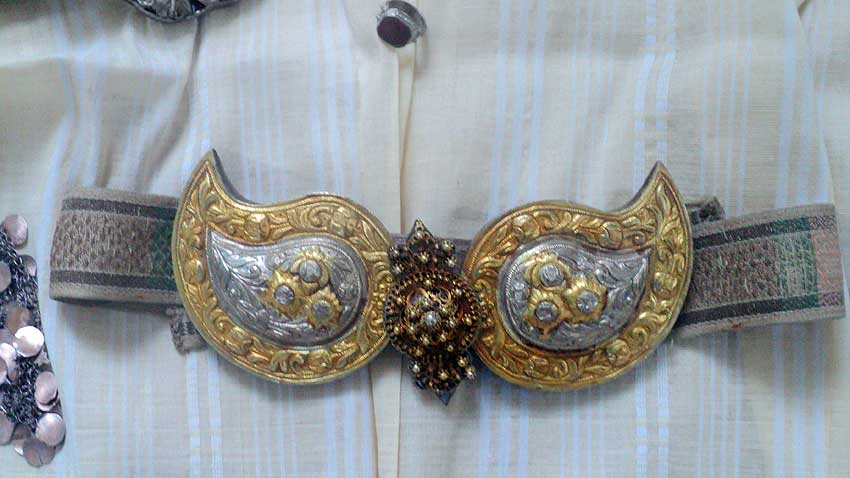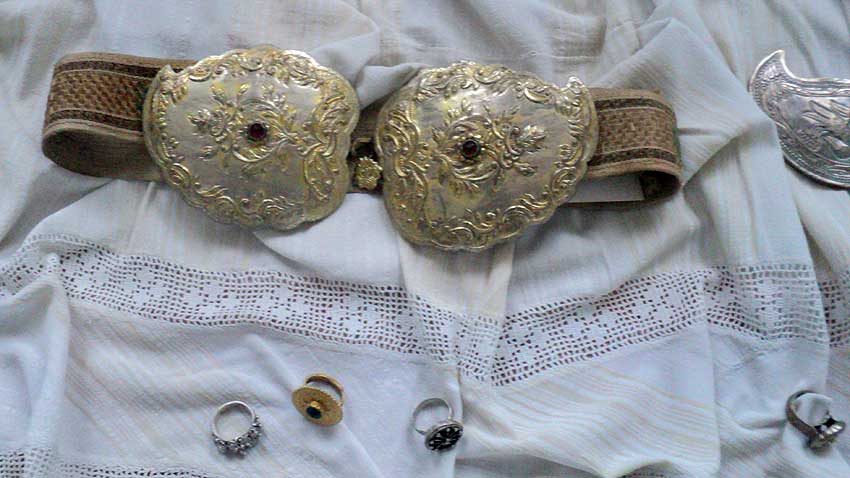Made of gold, silver and brass, women in Bulgaria invariably wore jewellery with their finest clothes. And as any object in traditional practices in this country, each item played a manifold role – serving as an adornment but also possessed of the power to ward off evil, an inseparable part of different customs and magic rituals. Jewellery is part of traditional beliefs and superstitions but also of traditional medicine.
Ornate belt buckles, bracelets, rings and necklaces all serve to ward off evil eyes and magic spells. They are worn on parts of the body that are considered vulnerable – the forehead, the ears, neck, and waist (called “half”) and the hands. These parts of the body are covered up during the wedding ritual, when a girl crosses life’s most important boundary – and there is good reason for this. The bride’s head is covered by a thick veil and she wears gold or silver jewellery. Over her forehead hangs a gold coin called a “ducat cross”, a coin that is made mention of in Christmas songs. The coin has to be pure gold because it attracts a bountiful harvest and peace to the home. People once believed that gold possessed great powers. That is why a gold coin was also threaded onto the baby bonnets or was tied on the newborn’s forehead.

The rituals in which bracelets, belt buckles, rings or earrings are used vary from region to region, but they have many things in common. For example, bracelets were vital in wedding rituals and customs. They were submerged in what was known as “coloured water”, the water used to knead bread. In some parts of Bulgaria, belt buckles were also put in the water. The young girls would take the bracelets to the well, singing songs all the way there. Placed in the water, the bracelets were left there until the water was warm enough for the dough to be kneaded. This was done to fend off the “evil eye” so that everything in the young bride’s family life would be “so full as to be smooth on all sides”. Women would take good care of their jewellery throughout their lives. When their children were born, a ring would be put into the first water the newborn was bathed in. On the third day after the child was born, a tray would be laid out for the baby with salt, bread and wine and next to the food – the belt buckles, bracelets etc. And all this was placed on the child’s head. The ritual objects were for the fairy godmothers who were said to come during the night to seal the child’s destiny.
Rings play a key role in prenuptial ritual practices. On the night preceding the New Year, St. George’s Day, Easter and Ascension Day, a ritual was performed known as “singing to the rings” that was supposed to predict whom the girl would marry. On St. George’s Day, the first milking was done “through a ring” to keep magic spells away from the sheep so they would give lots of milk in summer. On the same day a ring would be put into “silent water” (water brought from the well in complete silence). This water was used to sprinkle the flock with to keep roamers and evil sorcerers from “robbing the milk” (taking the milk from the sheep and “giving” it to another flock). The same water was used to sprinkle one of the fence pickets, on which a horse skull was, by a tradition placed - this was believed to keep wolves at bay. A similar ritual was performed at different times of the farming year. For example, before threshing-time, the stack yard was also sprinkled; according to popular belief this would bring a gentle breeze that would winnow the chaff and make for better quality wheat.

Together or separately, belt buckles, rings, bracelets and earrings were used by fortune tellers against “evil spells, fright, magic or other scourges”. If the young bride were to pass away, jewellery would also be placed in the clothes she was dressed in for the afterlife; it was believed that it would show her the way in the netherworld. It was said that if the rings, bracelets, earrings were to be dug up later, they would be even more potent in warding off bad magic. If, in a dream, you are wearing a ring on your finger that is a good sign – it means an acquisition, wealth awaits you.
English version: Milena Daynova
Photos: BTA and BGNESProducts made of wool inspire the feeling of inner comfort and warmth in the visitors of the Plovdiv Regional Ethnographic Museum. The exhibition "Bulgarian felts - a message from antiquity" presents an ancient craft, which is..
The Hague, a city in the south of the Netherlands, the administrative centre and the place where the Queen lives and works... Hardly anyone associates this city with Bulgarian folklore and traditions. But the fact is that the interest in..
On June 28 and 29th, the city of Razlog, in the region of Blagoevgrad, will present the magic of Bulgarian folklore. In these days, the XIII Festival of traditional horo dance will be held on the central square "Preobrazhenie". The..

+359 2 9336 661
